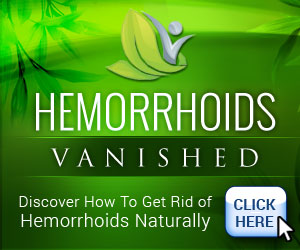Hemorrhoids Causes, Symptoms, Prevention and Treatment
Hemorrhoids, often called piles, are swollen and inflamed veins in and around the anus and lower rectum. They are much like varicose veins you might see on a person’s legs.
Hemorrhoids are a very common health problem. Hemorrhoids cause serious problems in about 4% (over 10 million) of people in the United States. Prevalence of hemorrhoidal disease increases with age until the seventh decade and then diminishes slightly. Hemorrhoids also increase in pregnancy due to direct pressure on the rectal veins.
Causes of hemorrhoids
Hemorrhoids are caused by too much pressure in the rectum, forcing blood to stretch and swell the blood vessels. People whose parents had hemorrhoids may be more likely to get them.
Most common causes of hemorrhoids:
** straining with bowel movements (from constipation or hard stools)
** diarrhea
** constant sitting
** sitting on the toilet for a long time
** childbirth
** pressure of the fetus in pregnant women
** heavy lifting
** familial tendency
** obesity
Symptoms
Symptoms of hemorrhoids include:
** rectal bleeding
** pain around the anus and rectum
** irritation and itching
** bulge or lump at the anus
Excessive straining, rubbing or cleaning the anus may worsen symptoms. In most cases, the symptoms of hemorrhoids will only last a few days. Not every one with hemorrhoids will experience symptoms.
Types of hemorrhoids
The type of hemorrhoid depends on where it occurs. There are two types of hemorrhoids: internal and external.
External hemorrhoids develop around the rim of the anus. External hemorrhoids cause most of the symptoms associated with hemorrhoids (pain, burning, and itching) because the skin around them is very sensitive. If an external hemorrhoid becomes strangulated (cut off from blood supply), a clot can form in it and become an excruciatingly painful thrombosed hemorrhoid. Thrombosis of an external hemorrhoid causes an anal lump that is very painful and often requires medical attention.
Internal hemorrhoids develop inside the passageway of the anus. Internal hemorrhoids are often present without causing any discomfort or even awareness of their presence. Internal hemorrhoids are usually painless, although they sometimes cause discomfort and bleeding if a hard stool rubs against them during a bowel movement. Internal hemorrhoids also may prolapse outside the anus, where they appear as small, grape-like masses. These can be painful. A prolapsed hemorrhoid will go back inside the rectum on its own, or you can gently press it back into the anus with your fingertips.
Internal hemorrhoids are classified by the degree of tissue prolapse into the anal canal:
** First-degree – hemorrhoids that bleed but do not prolapse
** Second-degree – hemorrhoids that prolapse with straining or defecating and retract on their own
** Third-degree – hemorrhoids that prolapse and require manual reduction
** Fourth-degree – hemorrhoids that chronically prolapse and, if reducible, fall out again
Mixed hemorrhoids are confluent internal and external hemorrhoids.
Prevention – You often can prevent hemorrhoids by preventing constipation and straining to have bowel movements. Some of the following diet and lifestyle changes may help you to soften the stool, and avoid the straining that can lead to hemorrhoids:
** Include more fiber in your diet – fresh fruits, leafy vegetables, and whole-grain breads and cereals are good sources of fiber.
** Drink adequate amounts of fluids – 6 to 8 glasses of water daily.
** Exercise regularly
** Do not strain or sit on the toilet for long periods of time. Straining for more than 5 minutes can be harmful. Try not to stay on the toilet any longer than necessary.
** Use a soothing wipe, such as baby wipes or witch hazel pads, to clean after each bowel movement and to ease the pain.
** If your main job activity is seated, always stand or walk during your breaks. Make it a point to stand and walk at least 5 minutes every hour and try to shift frequently in your chair to avoid direct rectal pressure.
** Avoid heavy lifting, which puts pressure on the anal opening.
Treatment
A number of surgical methods may be used to remove or reduce the size of hemorrhoids:
** Rubber band ligation – A rubber band is placed around the base of the hemorrhoid inside the rectum. The band cuts off circulation, and the hemorrhoid withers away within a few days.
** Sclerotherapy is one of the oldest forms of treatment. A chemical solution is injected directly into the hemorrhoid or the area around it. This solution causes a local reaction that interferes with blood flow inside the hemorrhoid, making the hemorrhoid shrink.
** Laser or electro-coagulation techniques – Both techniques use special devices to burn hemorrhoidal tissue.
** Cryotherapy uses cold temperatures to obliterate the veins and cause inflammation and scarring. It is more time consuming, associated with more posttreatment pain, and is less effective than other treatments. Therefore, this procedure is not commonly used.
** Hemorrhoidectomy – Occasionally, extensive or severe internal or external hemorrhoids may require removal by surgery known as hemorrhoidectomy. This is the best method for permanent removal of hemorrhoids. Hemorrhoidectomy is the treatment for severe third-degree and fourth-degree hemorrhoids.
Sclerotherapy, ligation, and heat coagulation are all good options for the treatment of hemorrhoids.
Neo Healar – herbal remedy for hemorrhoid Neo Healar is a 100% herbal product that is composed on four natural occurring plants: Lupinus Albus, Vateria Indica, Mentha Piperita and Aloe Vera. Neo Healar is available in two forms: 30 g ointment and suppositories (in 10s).




